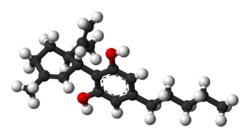Also known as CBD is one of the most prevalent cannabinoids found in cannabis with enormous therapeutic potential. CBD is non-intoxicating, meaning it does not produce the “high” feeling associated with marijuana. Scientists refer to CBD as a “promiscuous” compound because it causes positive therapeutic impacts in many different ways while tapping into how we function physiologically and biologically.
Cannabidiol (CBD) is a phytocannabinoid discovered in 1940. It is one of 113 identified cannabinoids in cannabis plants, along with tetrahydrocannabinol (THC), and accounts for up to 40% of the plant's extract. As of 2019[update], clinical research on CBD included studies related to anxiety, cognition, movement disorders, and pain, but there is insufficient high-quality evidence that cannabidiol is effective for these conditions. Nevertheless, CBD is a popular herbal drug, widely promoted with claims of particular therapeutic benefits. The global market size for CBD was predicted to exceed US$47 billion by 2028.
 | |
 | |
| Clinical data | |
|---|---|
| Trade names | Epidiolex, Epidyolex |
| Other names | CBD, cannabidiolum, (−)-cannabidiol |
| AHFS/Drugs.com | Monograph |
| MedlinePlus | a618051 |
| License data |
|
| Pregnancy category |
|
| Routes of administration | Inhalation (smoking, vaping), buccal (aerosol spray), oral (solution) |
| Drug class | Cannabinoid |
| ATC code | |
| Legal status | |
| Legal status |
|
| Pharmacokinetic data | |
| Bioavailability | • Oral: 6% (fasted) • Inhaled: 31% (11–45%) |
| Elimination half-life | 18–32 hours |
| Identifiers | |
| |
| CAS Number | |
| PubChem CID | |
| IUPHAR/BPS | |
| DrugBank | |
| ChemSpider | |
| UNII | |
| KEGG | |
| ChEBI | |
| PDB ligand | |
| CompTox Dashboard (EPA) | |
| ECHA InfoCard | 100.215.986 |
| Chemical and physical data | |
| Formula | C21H30O2 |
| Molar mass | 314.469 g·mol−1 |
| 3D model (JSmol) | |
| Melting point | 66 °C (151 °F) |
| Solubility in water | insoluble |
| |
| |
| (verify) | |
Cannabidiol can be taken internally in multiple ways, including by inhaling cannabis smoke or vapor, by mouth, and as an aerosol spray into the cheek. It may be supplied as CBD oil containing only CBD as the active ingredient (excluding tetrahydrocannabinol [THC] or terpenes), CBD-dominant hemp extract oil, capsules, dried cannabis, or prescription liquid solution. CBD does not have the same psychoactivity as THC, and will negate the psychoactive effects of THC on the body if both are present. As of 2018[update], the mechanism of action for its biological effects has not been determined. Unlike THC, which acts on the cannabinoid receptor type 1 (CB1) as a partial agonist, CBD instead is a negative allosteric modulator of CB1 receptors.
In the United States, the cannabidiol drug Epidiolex was approved by the Food and Drug Administration in 2018 for the treatment of two epilepsy disorders. While the 2018 United States Farm Bill removed hemp and hemp extracts (including CBD) from the Controlled Substances Act, the marketing and sale of CBD formulations for medical use or as an ingredient in dietary supplements or manufactured foods remains illegal under FDA regulation, as of 2021.
English
Etymology
From cannabis + diol.
Pronunciation
- (Received Pronunciation) IPA(key): /kan.əb.ɪˈdʌɪ.ɒl/
- (General American) IPA(key): /kæn.əb.ɪˈdaɪ.ɔl/,



